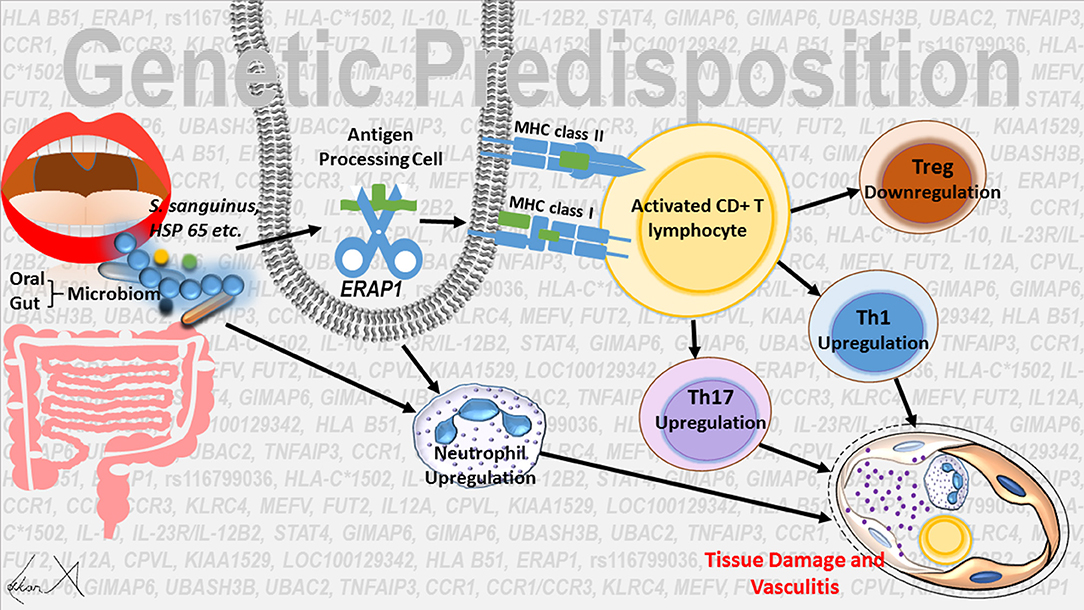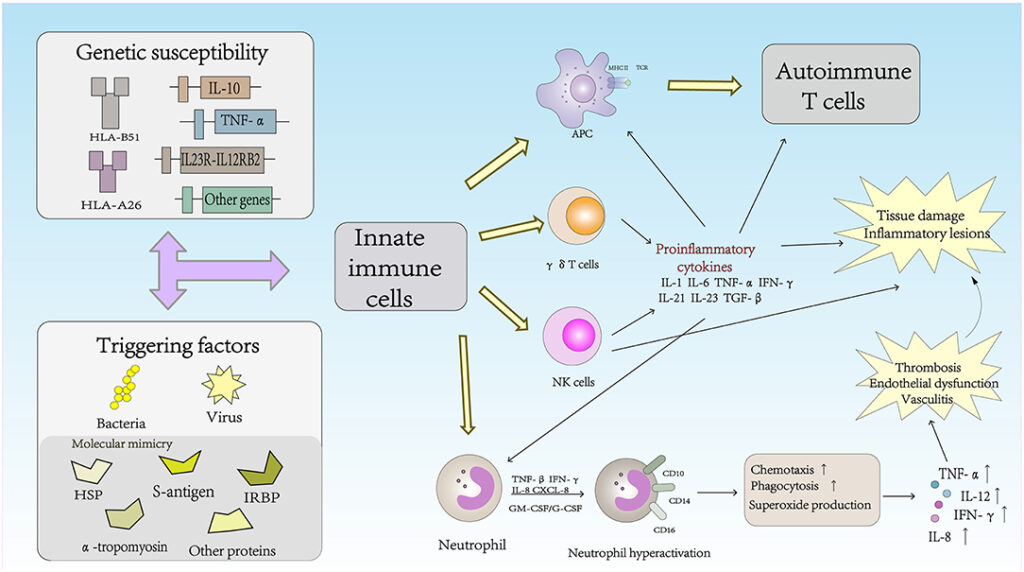Behcet’s Syndrome, also known as Behcet’s Disease (BD), is a rare and chronic inflammatory condition that affects multiple systems in the body. It is characterized by recurring symptoms such as mouth ulcers, genital sores, eye inflammation, and skin lesions. This complex disorder can impact various organs and tissues, making it challenging to diagnose and manage. In this article, we will explore the key aspects of this condition, including its causes, symptoms, and available treatments.

What is Behcet’s Syndrome?
Behcet’s Syndrome is an autoimmune disorder where the immune system mistakenly attacks the body’s own tissues. This leads to widespread inflammation, which can affect blood vessels of all sizes throughout the body. The disease was first described in 1937 by a Turkish dermatologist named Hulusi Behcet, after whom it is named. While it is most commonly found in regions along the ancient Silk Road, including Turkey, Iran, and Japan, it can occur in people of any ethnicity or geographic location.
Prevalence and Demographics
- Behcet’s Syndrome is more common in certain populations, particularly those from the Mediterranean, Middle East, and East Asia.
- It typically affects individuals between the ages of 20 and 40, though cases have been reported in younger and older individuals.
- Men and women are both affected, but men often experience more severe symptoms compared to women.
Possible Causes of Behcet’s Syndrome
The exact cause of Behcet’s Syndrome remains unknown, but researchers believe it results from a combination of genetic, environmental, and immunological factors.
Genetic Factors
Studies suggest that certain genetic markers may increase the risk of developing Behcet’s Syndrome. One of the most significant genetic links is with the human leukocyte antigen (HLA) gene, specifically the HLA-B51 variant. However, not everyone with this genetic marker develops the condition, indicating that other factors must also play a role.
Environmental Triggers
Environmental factors, such as infections or exposure to certain bacteria or viruses, may trigger the onset of Behcet’s Syndrome in genetically predisposed individuals. Some researchers propose that Streptococcus bacteria could be involved, although no definitive evidence has been established.
Immune System Dysfunction
Behcet’s Syndrome is classified as an autoimmune disorder because the immune system mistakenly targets healthy cells and tissues. This abnormal immune response leads to inflammation in various parts of the body, contributing to the diverse range of symptoms experienced by patients.
Common Symptoms of Behcet’s Syndrome
The symptoms of Behcet’s Syndrome vary widely among individuals and can change over time. They often come and go in flares, followed by periods of remission when symptoms subside. Below are some of the most common manifestations:
Mouth Ulcers
Recurrent mouth ulcers are one of the hallmark symptoms of Behcet’s Syndrome. These painful sores typically appear on the tongue, gums, inner cheeks, or lips and resemble canker sores. Unlike typical canker sores, however, they tend to recur frequently and heal slowly.
Genital Sores
Similar to mouth ulcers, genital sores occur in many individuals with Behcet’s Syndrome. These lesions are usually painful and can develop on the scrotum in men or the vulva in women. They may leave scars after healing.
Eye Inflammation
Inflammation of the eyes, known as uveitis, is another frequent symptom. Uveitis can cause redness, pain, blurred vision, and sensitivity to light. If left untreated, it may lead to permanent vision loss.
Skin Lesions
Many patients develop skin rashes or lesions, which can take several forms. Erythema nodosum, characterized by raised, tender bumps under the skin, is one example. Another common feature is acne-like eruptions on the upper body.
Joint Pain
Joint pain and swelling, particularly in the knees, ankles, wrists, or elbows, are prevalent in Behcet’s Syndrome. This arthritis-like symptom usually resolves within a few weeks without causing long-term damage.
Gastrointestinal Issues
Some individuals experience gastrointestinal problems similar to those seen in Crohn’s disease or ulcerative colitis. Symptoms include abdominal pain, diarrhea, and bleeding due to ulcers in the digestive tract.
Vascular Complications
Because Behcet’s Syndrome involves inflammation of blood vessels, it can lead to complications such as blood clots, aneurysms, or blockages in arteries and veins. These issues pose serious risks if not addressed promptly.
Neurological Symptoms
In rare cases, Behcet’s Syndrome affects the central nervous system, leading to headaches, confusion, memory problems, or even stroke-like symptoms. This form of the disease is referred to as neuro-Behcet’s Syndrome.
Treatment Options for Behcet’s Syndrome
There is currently no cure for Behcet’s Syndrome, but treatment focuses on managing symptoms, reducing inflammation, and preventing complications. A multidisciplinary approach involving rheumatologists, ophthalmologists, dermatologists, and other specialists is often necessary to provide comprehensive care.
Medications for Symptom Management
Several types of medications are used to control the symptoms of Behcet’s Syndrome:
- Corticosteroids: These anti-inflammatory drugs help reduce acute flare-ups and are often prescribed for severe symptoms like eye inflammation or major organ involvement.
- Immunosuppressants: Medications such as azathioprine, cyclosporine, or methotrexate suppress the overactive immune response and are useful for long-term management.
- Biologic Therapies: Drugs like tumor necrosis factor (TNF) inhibitors have shown promise in treating refractory cases of Behcet’s Syndrome, especially when conventional therapies fail.
- Topical Treatments: Mouthwashes, creams, or gels containing corticosteroids or local anesthetics can alleviate discomfort caused by oral and genital ulcers.
Lifestyle Modifications
Besides medication, lifestyle changes can help improve quality of life for individuals with Behcet’s Syndrome:
- Avoiding triggers such as stress, poor diet, or excessive sun exposure can minimize flare-ups.
- Regular exercise and maintaining a balanced diet support overall health and well-being.
- Quitting smoking is strongly recommended, as tobacco use can worsen symptoms and increase the risk of vascular complications.
Monitoring and Follow-Up Care
Due to the unpredictable nature of Behcet’s Syndrome, regular monitoring by healthcare providers is essential. Routine check-ups allow doctors to assess the effectiveness of treatment, detect potential complications early, and adjust therapies as needed.
Living with Behcet’s Syndrome
Managing Behcet’s Syndrome requires patience and persistence, as the disease can significantly impact daily life. Patients are encouraged to educate themselves about their condition, seek support from patient advocacy groups, and communicate openly with their healthcare team. By staying proactive and adhering to treatment plans, individuals with Behcet’s Syndrome can achieve better outcomes and maintain a fulfilling lifestyle despite the challenges posed by the disease.





